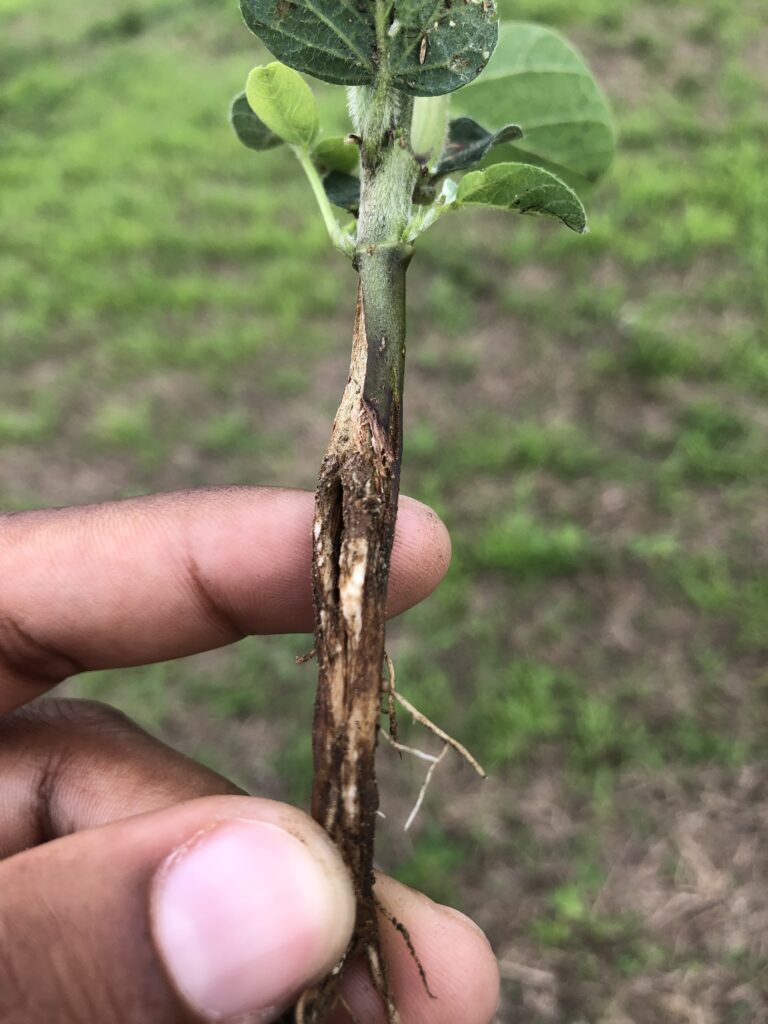Main Content
In July, a farmer called about a soybean field planted 5 weeks earlier seemingly stuck at the V2-V3 stage. Planning for a post emergence herbicide application was underway and the farmer wanted advice if anything could be done to help the beans such as additional fertilizer, a fungicide, or an insecticide. Would the better decision be to avoid the additional cost of herbicide application all together if the beans were destined to not yield anything? Always a tough decision, to abandon the crop to cut losses.

Field and Crop History
This field was planted in hay for three years prior to soybeans. The grower reported poor hay yields in the third year and attributed this to the cool, wet season. Herbicides used in the hay were 2,4-D and Banvel. Hay was terminated in fall 2020 with Gramoxone. The ground was worked, and soybeans were drilled in mid-June.
Field, Soil, and Plant Inspection
At first glance, it was difficult to tell soybeans were even planted. In addition to the reported short, stunted beans, there was noticeable deer damage and plenty of weed cover. The most puzzling observation was how well-distributed the stunting was across the field; not something we associate with pests and disease, or possible herbicide drift. There were some scattered plants growing somewhat better than others, but across the entire field the soybeans were clearly struggling.
Inspection of individual plants revealed thickened and hardened stems at the soil level, as well as cracking of the stems (Photo 1). Root development was less than optimal. There was no evidence of insects or disease. The farmer indicated planting depth was not an issue. Initial crop emergence was reported as rapid and uniform. We discussed a previous issue with nematodes in a small area of the adjacent field and examined the 2020 soil test from the field. Ultimately ruled out were nematodes, soil pH, and nutrient deficiencies. Herbicide carryover was also ruled out as none of the previous herbicides on the hay had residual activity.
Diagnosis – Soil Compaction
With no obvious conclusions and frustration beginning to set in, the focus shifted to possible soil compaction. We returned with a soil compaction probe and found a hardpan beginning 3-inches down in the soil profile, and this was observed across the entire field. The compaction probe indicated resistance of 200 – 300 psi to a 10-12 inch depth.
Plans – Now and Future
Unfortunately, this crop of soybeans will not likely rebound. There is no in season rescue treatment that can remedy the compaction and preserve the existing crop. It is also too late in the season to till the ground and plant again.
Compaction does not develop overnight, and it cannot be remedied overnight. Modification of soil management practices over the long-term is essential to prevent compaction in the future.
Compaction at this site was relatively shallow, so we recommended the farmer start by deep chisel plowing during dry soil conditions to help loosen the existing compaction. Be aware, tillage to remedy compaction is not a treadmill you want to get on. The best practice is to limit equipment operations on wet soils. We recognize this is not always possible, so additional best practices include controlling traffic across the field, reducing axle loads, and insuring proper inflation and size of tires (see this University of Minnesota article for more information).
Additionally, soil organic matter content is an important factor in compaction risk as soil organic matter improves soil structure. Promoting soil tilth, in this way, reduces compaction risk. Prevent loss of soil organic matter by minimizing tillage (or tillage intensity) and build soil organic matter by planting cover crops and rotating with perennial crops.